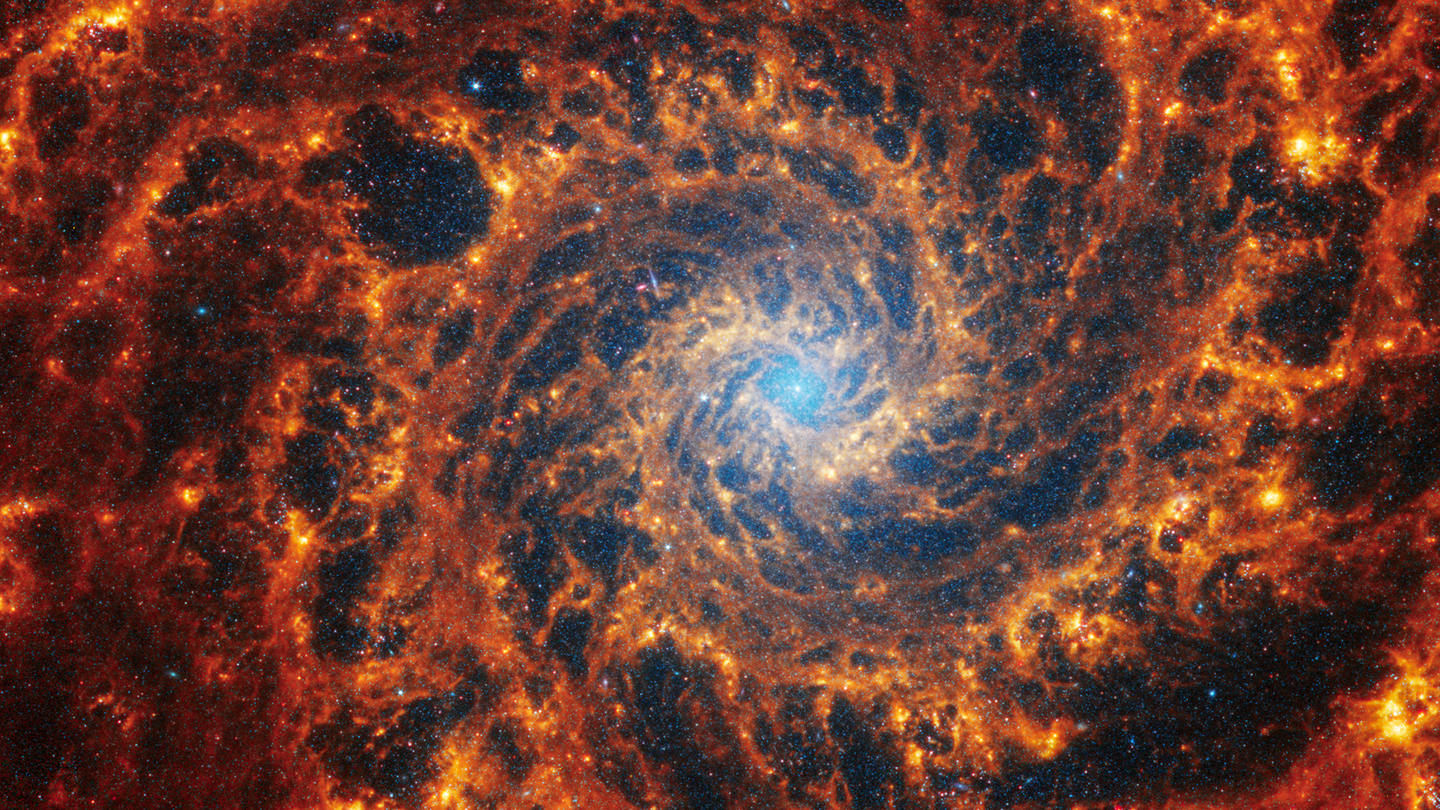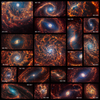The stars, dust, and gas swirling around black holes could reveal the origin of some our universe’s most intricate structures.
By
Laura Baisas
|
Published Jan 29, 2024 2:15 PM EST

Face-on spiral galaxy, NGC 628, is split diagonally in this image: The James Webb Space Telescope’s observations appear at top left, and the Hubble Space Telescope’s on bottom right. JWST’s observations combine near- and mid-infrared light and Hubble’s showcase visible light. Dust absorbs ultraviolet and visible light, and then re-emits it in the infrared. In JWST’s images, we see dust glowing in infrared light. In Hubble’s images, dark regions are where starlight is absorbed by dust. NASA, ESA, CSA, STScI, Janice Lee (STScI), Thomas Williams (Oxford), PHANGS Team
Astronomers using the James Webb Space Telescope (JWST) have released new images of 19 nearby face-on spiral galaxies seen in a combination of near- and mid-infrared light. Spiral galaxies are some of the universe’s most awe-inspiring bodies. Their buff and wavy arms are chock full of stars arranged in a whirlpool pattern with vibrant colors and light. According to the European Space Agency (ESA), the most visually spectacular spiral galaxies are considered “face-on,” which means that their spiral arms and bulge are clearly visible.
[Related: Elliptical galaxies may just be spiral galaxies with their arms lobbed off.]
These new images combine years of data collected from multiple different telescopes to paint a more complete picture of these whirly spiral galaxies and how they form.
“I feel like our team lives in a constant state of being overwhelmed–in a positive way–by the amount of detail in these images,” Thomas Williams, a postdoctoral researcher from the University of Oxford in the United Kingdom, said in a statement.
Tracing spiral arms
JWST’s Near-Infrared Camera (NIR-Cam) captured millions of stars that appear in blue tones in the new images. Some of the stars appear climbed tightly together in clusters, while others are spread along the spiral arms.
The telescope’s Mid-Infrared Instrument (MIRI) data shows where glowing space dust exists around and between the stars. It also shows some stars that have not fully formed. These stars are still encased in the dust and gas that fuel their growth.
 A collection of 19 face-on spiral galaxies from the James Webb Space Telescope in near- and mid-infrared light. CREDIT: Image NASA, ESA, CSA, STScI, Janice Lee (STScI), Thomas Williams (Oxford), PHANGS Team. Designer: Elizabeth Wheatley (STScI)
A collection of 19 face-on spiral galaxies from the James Webb Space Telescope in near- and mid-infrared light. CREDIT: Image NASA, ESA, CSA, STScI, Janice Lee (STScI), Thomas Williams (Oxford), PHANGS Team. Designer: Elizabeth Wheatley (STScI)
“These are where we can find the newest, most massive stars in the galaxies,” Erik Rosolowsky, a physicist from the University of Alberta in Canada, said in a statement.
The JWST images also show large, spherical shells in the gas and dust. According to the team, these holes were potentially created by one or more stars that exploded. The explosion then carved out giant holes in interstellar material.
The spiral arms also reveal the extended regions of gas that appear red and orange in the new images.
“These structures tend to follow the same pattern in certain parts of the galaxies,” Rosolowsky added. “We think of these like waves, and their spacing tells us a lot about how a galaxy distributes its gas and dust.”
Further research into these structures could provide key insights into how galaxies in our universe build, maintain, and stop star formation.
Center of the galaxy
Spiral galaxies likely grow from the inside out. Stars will begin to form at the core of the galaxy before spreading along the arms and spiraling away from the center. The location of the stars can also provide clues to their ages. The younger stars are most likely the ones the furthest away from the galaxy’s core. The areas closest to the core that appear to be illuminated by a blue spotlight are believed to be the older stars.
 Face-on barred spiral galaxy, NGC 1512, is split diagonally in this image. The JWST’s observations appear at top left, and the Hubble Space Telescope’s on bottom right. JWST’s observations combine near- and mid-infrared light and Hubble’s showcase visible and ultraviolet light. Dust absorbs ultraviolet and visible light, and then re-emits it in the infrared. In JWST’s images, we see dust glowing in infrared light. In Hubble’s images, dark regions are where starlight is absorbed by dust. CREDIT: NASA, ESA, CSA, STScI, Janice Lee (STScI), Thomas Williams (Oxford), PHANGS Team
Face-on barred spiral galaxy, NGC 1512, is split diagonally in this image. The JWST’s observations appear at top left, and the Hubble Space Telescope’s on bottom right. JWST’s observations combine near- and mid-infrared light and Hubble’s showcase visible and ultraviolet light. Dust absorbs ultraviolet and visible light, and then re-emits it in the infrared. In JWST’s images, we see dust glowing in infrared light. In Hubble’s images, dark regions are where starlight is absorbed by dust. CREDIT: NASA, ESA, CSA, STScI, Janice Lee (STScI), Thomas Williams (Oxford), PHANGS Team
The galaxy cores in pink and red spikes may be a sign of a giant and non-dormant black hole.
“That’s a clear sign that there may be an active supermassive black hole,” Eva Schinnerer, a staff scientist at the Max Planck Institute for Astronomy in Germany, said in a statement. “Or, the star clusters toward the center are so bright that they have saturated that area of the image.”
Sinking PHANGS into space
The images are part of a long-standing project called PHANGS–Physics at High Angular resolution in Nearby GalaxieS. It is supported by over 150 astronomers worldwide. Before JWST created the images, PHANGS was already analyzing large amounts of data from NASA’s Hubble Space Telescope, the Very Large Telescope’s Multi-Unit Spectroscopic Explorer, and the Atacama Large Millimeter/submillimeter Array.
[Related: Bursting stars could explain why it was so bright after the big bang.]
These previous observations were taken in ultraviolet, visible, and radio light. JWST’s new near- and mid-infrared contributions have provided several pieces of evidence to the study of spiral galaxies.
 Face-on spiral galaxy, NGC 4535. The gas and dust stand out in stark shades of orange and red, and show finer spiral shapes with the appearance of jagged edges. These are some of the star-forming regions of the galaxy. Both older and younger stars appear blue in color. CREDIT: NASA, ESA, CSA, STScI, Janice Lee (STScI), Thomas Williams (Oxford), PHANGS Team.
Face-on spiral galaxy, NGC 4535. The gas and dust stand out in stark shades of orange and red, and show finer spiral shapes with the appearance of jagged edges. These are some of the star-forming regions of the galaxy. Both older and younger stars appear blue in color. CREDIT: NASA, ESA, CSA, STScI, Janice Lee (STScI), Thomas Williams (Oxford), PHANGS Team.
“Webb’s new images are extraordinary,” Janice Lee, a project scientist for strategic initiatives at the Space Telescope Science Institute in Maryland, said in a statement. “They’re mind-blowing even for researchers who have studied these same galaxies for decades. Bubbles and filaments are resolved down to the smallest scales ever observed, and tell a story about the star formation cycle.”
In addition to these new images, the PHANGS team has also released the largest catalog to date of about 100,000 star clusters which may help astronomers learn more about their stellar lives.
“Stars can live for billions or trillions of years,” Ohio State University astronomer Adam Leroy said in a statement. “By precisely cataloging all types of stars, we can build a more reliable, holistic view of their life cycles.”

>>> Read full article>>>
Copyright for syndicated content belongs to the linked Source : Popular Science – https://www.popsci.com/science/jwst-new-spiral-galaxies/






























